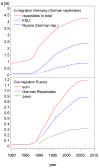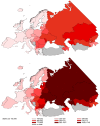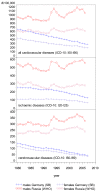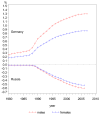Time trends in cardiovascular disease mortality in Russia and Germany from 1980 to 2007 - are there migration effects?
- PMID: 20716332
- PMCID: PMC2928205
- DOI: 10.1186/1471-2458-10-488
Time trends in cardiovascular disease mortality in Russia and Germany from 1980 to 2007 - are there migration effects?
Abstract
Background: Cardiovascular disease (CVD) is the leading cause of death in the industrialized world. Large variations in CVD mortality between countries and also between population subgroups within countries have been observed. Previous studies showed significantly lower risks in German repatriates and Jews emigrating from Russia than in the general Russian population. We examined to what degree the migration of large subgroups influenced national CVD mortality rates.
Methods: We used WHO data to map the CVD mortality distribution in Europe in 2005. Supplemented by data of the Statistisches Bundesamt, the mortality trends in three major CVD groups between 1980 and 2007 in Russia and Germany are displayed, as well as demographic information. The effects of migration on demography were estimated and percentage changes in CVD mortality trends were calculated under the assumption that migration had not occurred.
Results: Cardiovascular disease mortality patterns within Europe showed a strong west-east gradient with ratios up to sixfold. In Germany, the CVD mortality levels were low and steadily decreasing, whereas in Russia they fluctuated at high levels with substantial differences between the sexes and strong correlations with political changes and health campaigns. The trends in both Russia and Germany were affected by the migration that occurred in both countries over recent decades. However, our restricted focus in only adjusting for the migration of German repatriates and Jews had moderate effects on the national CVD mortality statistics in Germany (+1.0%) and Russia (-0.6%).
Conclusions: The effects on CVD mortality rates due to migration in Germany and Russia were smaller than those due to secular economical changes. However, migration should still be considered as a factor influencing national mortality trends.
Figures







Similar articles
-
Myocardial infarction incidence and ischemic heart disease mortality: overall and trend results in repatriates, Germany.Eur J Public Health. 2014 Feb;24(1):127-33. doi: 10.1093/eurpub/ckt058. Epub 2013 May 31. Eur J Public Health. 2014. PMID: 23729483
-
[Mortality of working age population in Russia and indusrial countries in Europe: trends of the last two decades].Vestn Ross Akad Med Nauk. 2014;(7-8):121-6. doi: 10.15690/vramn.v69i7-8.1118. Vestn Ross Akad Med Nauk. 2014. PMID: 25563013 Russian.
-
[Cardiovascular mortality in the Russian Federation and possible mechanisms of its changes].Zh Nevrol Psikhiatr Im S S Korsakova. 2018;118(8):98-103. doi: 10.17116/jnevro201811808198. Zh Nevrol Psikhiatr Im S S Korsakova. 2018. PMID: 30251986 Russian.
-
Contributions of risk factors and medical care to cardiovascular mortality trends.Nat Rev Cardiol. 2015 Sep;12(9):508-30. doi: 10.1038/nrcardio.2015.82. Epub 2015 Jun 16. Nat Rev Cardiol. 2015. PMID: 26076950 Free PMC article. Review.
-
The health status of Russian-speaking immigrants in Germany.Horm Metab Res. 2007 Dec;39(12):858-61. doi: 10.1055/s-2007-993153. Horm Metab Res. 2007. PMID: 18075968 Review.
Cited by
-
East-West gradient in cardio-vascular mortality in Austria: how much can we explain by following the pattern of risk factors?Int J Health Geogr. 2011 Nov 14;10:59. doi: 10.1186/1476-072X-10-59. Int J Health Geogr. 2011. PMID: 22082341 Free PMC article.
-
Epidemiology and the Magnitude of Coronary Artery Disease and Acute Coronary Syndrome: A Narrative Review.J Epidemiol Glob Health. 2021 Jun;11(2):169-177. doi: 10.2991/jegh.k.201217.001. Epub 2021 Jan 7. J Epidemiol Glob Health. 2021. PMID: 33605111 Free PMC article. Review.
-
Implications of the 2021 ESC cardiovascular risk classification among 283,000 European immigrants living in a low-risk region: a population-based analysis in Catalonia.Arch Med Sci. 2021 Dec 7;19(1):35-45. doi: 10.5114/aoms/144631. eCollection 2023. Arch Med Sci. 2021. PMID: 36817660 Free PMC article.
-
Causes of death and trends in mortality from the year 2000 to 2017 in patients with acute myocardial infarction.Ann Med. 2024 Dec;56(1):2424449. doi: 10.1080/07853890.2024.2424449. Epub 2024 Nov 18. Ann Med. 2024. PMID: 39552334 Free PMC article.
-
Austerity Policies and Mortality in Spain After the Financial Crisis of 2008.Am J Public Health. 2018 Aug;108(8):1091-1098. doi: 10.2105/AJPH.2018.304346. Am J Public Health. 2018. Retraction in: Am J Public Health. 2019 Jul;109(7):e17. doi: 10.2105/AJPH.2019.305147. PMID: 29995474 Free PMC article. Retracted.
References
-
- Ali M, Beusenberg M, Bloessner M, Boschi Pinto C, Briand S, Burton A, Cameron A, Cappa C. World Health Statistics 2009. 2009. http://www.who.int/whosis/whostat/EN_WHS09_Full.pdf
-
- Wilson PW, D'Agostino RB, Levy D, Belanger AM, Silbershatz H, Kannel WB. Prediction of coronary heart disease using risk factor categories. Circulation. 1998;97:1837–1847. - PubMed
Publication types
MeSH terms
LinkOut - more resources
Full Text Sources

